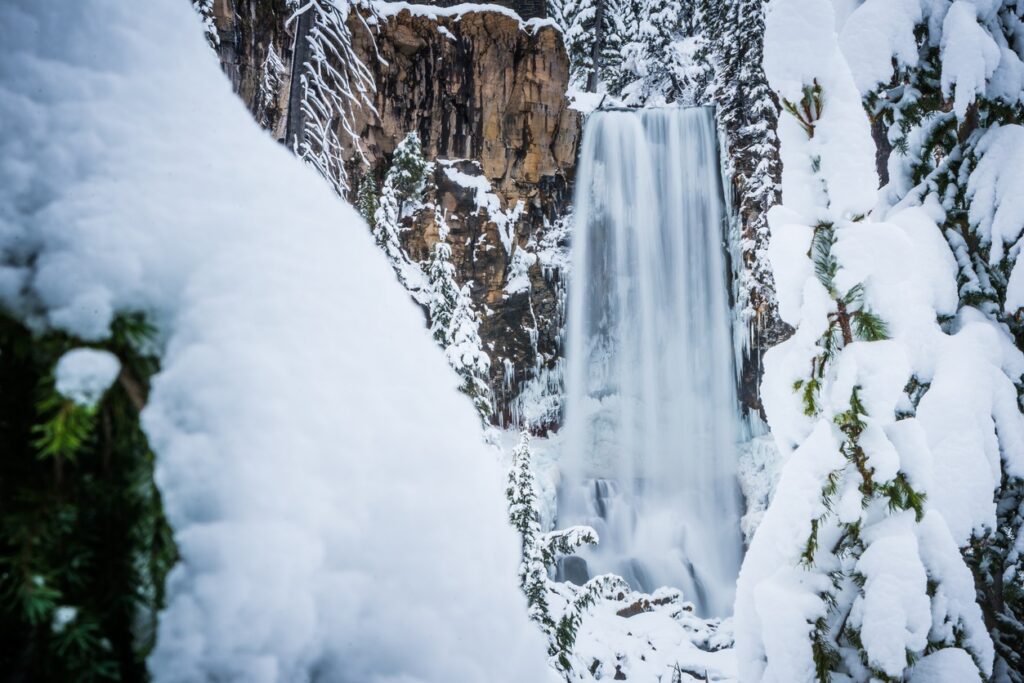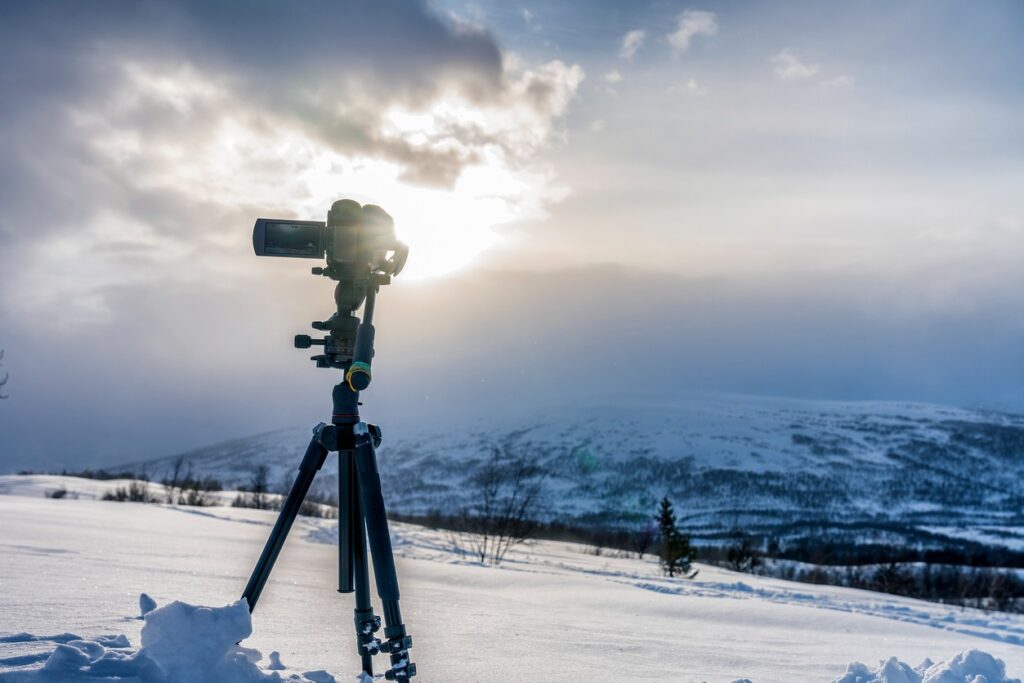
Winter in Bend, Oregon, transforms the city and surrounding area into a photographer’s paradise. The season blankets the landscape in a serene white, offering unique opportunities to capture the essence of the region’s natural beauty. From the tranquil Deschutes River winding through the city to the majestic Cascade Mountains, Bend’s winter scenery is diverse and breathtaking.
Key locations for winter photography in Bend include the picturesque Deschutes River, particularly at Drake Park and Farewell Bend Park. Drake Park, known for its mature trees and stunning views of local volcanoes, becomes even more enchanting in winter. Farewell Bend Park, near the Old Mill District, offers a striking contrast of the river against basalt cliffs and mountain views.
For those seeking the allure of winter wilderness, the Oregon Badlands Wilderness and the Three Sisters Wilderness present a pristine backdrop. The Oregon Badlands, with its high desert landscapes, becomes especially magical during the golden hour, while the snow-capped peaks of the Three Sisters offer awe-inspiring vistas.
Waterfall enthusiasts will find Benham Falls and Tumalo Falls particularly captivating in winter. Benham Falls offers a dynamic view of whitewater, while Tumalo Falls, nearly 100 feet tall, is a spectacle from various angles.
Mt. Bachelor and Sparks Lake provide stunning mountainous and lake scenes, respectively. Smith Rock State Park, with its dramatic rock formations, offers a striking contrast in the snow, ideal for landscape photography.
Additionally, Pilot Butte and Lava Butte are excellent for panoramic shots, including sunset views over the Cascade Mountains.
Key locations for winter photography in Bend include the picturesque Deschutes River, particularly at Drake Park and Farewell Bend Park. Drake Park, known for its mature trees and stunning views of local volcanoes, becomes even more enchanting in winter. Farewell Bend Park, near the Old Mill District, offers a striking contrast of the river against basalt cliffs and mountain views.
For those seeking the allure of winter wilderness, the Oregon Badlands Wilderness and the Three Sisters Wilderness present a pristine backdrop. The Oregon Badlands, with its high desert landscapes, becomes especially magical during the golden hour, while the snow-capped peaks of the Three Sisters offer awe-inspiring vistas.
Waterfall enthusiasts will find Benham Falls and Tumalo Falls particularly captivating in winter. Benham Falls offers a dynamic view of whitewater, while Tumalo Falls, nearly 100 feet tall, is a spectacle from various angles.
Mount Bachelor and Sparks Lake provide stunning mountainous and lake scenes, respectively. Smith Rock State Park, with its dramatic rock formations, offers a striking contrast in the snow, ideal for landscape photography.
Additionally, Pilot Butte and Lava Butte are excellent for panoramic shots, including sunset views over the Cascade Mountains.
8 Best Winter Photo Spots in Bend, Oregon
Each of these locations provides a unique glimpse into Bend’s winter wonderland, making the city a must-visit destination for photographers during the colder months. Bend, Oregon, offers a variety of stunning photo spots, particularly during winter. Here are some of the best locations in and around the Bend area:
- Deschutes River: The Deschutes River provides numerous picturesque scenes, particularly around Drake Park and Farewell Bend Park. Drake Park is notable for its mature trees and views of the local volcanoes, while Farewell Bend Park offers contrasting views of the river against towering basalt cliffs.
- Oregon Badlands Wilderness: For those interested in capturing high desert landscapes, this area is ideal, especially during the golden hour. It’s also a great spot for night photography due to the absence of city lights.
- Benham Falls and Tumalo Falls: These are great spots for waterfall photography. Benham Falls offers views of a churning stretch of whitewater, and Tumalo Falls is almost 100 feet tall, providing several angles for stunning photos.
- Mt. Bachelor, Sparks Lake, and Smith Rock State Park: These locations offer diverse landscapes, from snowy mountain scenes at Mount Bachelor to the serene icy wonderland of Sparks Lake, and the dramatic rock formations of Smith Rock State Park.
- Pilot Butte and Lava Butte: These locations offer panoramic views, including sunset shots over the Cascade Mountains from Pilot Butte and unique landscapes of frozen lava from Lava Butte.
- Trails Along Old Mill and the Deschutes River Trail: These trails provide opportunities for capturing the natural beauty of the river and the surrounding areas, including pine forests and lava flows.
- Three Sisters Wilderness and Tumalo Falls Winter Hike: These areas are perfect for capturing snow-capped peaks and serene winter landscapes.
- Cross-Country Skiing and Snowshoeing Trails: The snow-covered trails around Bend, such as Virginia-Meissner Sno-Park and Swampy Lakes Sno-Park, offer beautiful scenes of outdoor activities for winter photography.
Each of these locations provides a unique perspective of Bend’s natural beauty, especially in the winter months. Whether you’re interested in landscapes, waterfalls, or night photography, Bend has a variety of spots to explore and capture stunning photographs.
Black-and-White Vs. Color?
Choosing between black and white or color for outdoor winter photography depends on your artistic vision and the mood you want to convey. Black and white photography is excellent for emphasizing contrasts, textures, and shapes, particularly in snow-covered landscapes where color is minimal. It can lend a timeless, classic feel to your images, highlighting the stark beauty of winter scenes. On the other hand, color photography captures the subtle hues of winter light, from the warm glow of golden hour to the cool blues of shadows in the snow. Color can bring life and depth to winter scenes, showcasing the chilly atmosphere and occasional bursts of color in an otherwise monochrome landscape. Ultimately, the choice should reflect your creative intent and the story you wish to tell through your photographs.
11 Tips for Photographing Winter in Bend, Oregon

Photographing the winter landscape in Bend, Oregon, can be an incredibly rewarding experience, but it also comes with its unique set of challenges. Here are some tips to help you capture the best winter photos in this picturesque region:
- Understand the Light: Winter light can be tricky, often leading to underexposed or overexposed shots. Use your camera’s histogram to check the exposure. The soft light during the “golden hour” (shortly after sunrise or before sunset) offers the most dramatic lighting conditions for photography.
- Capture the Snow’s True Color: Snow often appears blue in photographs due to the sky’s reflection on a sunny day or a camera’s auto white balance setting. Adjust the white balance manually to capture the true color of the snow.
- Protect Your Gear: Low temperatures can drain your camera’s battery quickly, especially at higher altitudes. Carry spare batteries and keep them warm, possibly in an inside pocket of your coat. Also, protect your camera from snow and moisture using a waterproof bag or cover.
- Dress Appropriately: Wear layers to keep warm during inclement weather, and use gloves that allow you to operate your camera controls. Good footwear is essential to safely navigate icy and snowy terrains.
- Use a Tripod: A tripod is essential for stability, especially in low-light conditions. It also allows for long exposure shots, which can be very effective in winter landscapes.
- Pay Attention to Composition: Look for contrasts in the landscape, like a dark tree against a white snow background. Use leading lines, such as trails or streams, to draw the viewer’s eye into the photograph.
- Be Mindful of Weather Conditions: Check the weather forecast and be prepared for sudden changes in Bend weather. According to historic weather data, the average temperature in winter ranges from the low 20s to mid 40s with low relative humidity and the average annual snowfall is nearly 34 inches. Safety should always be your top priority.
- Respect Nature and Wildlife: Be mindful of your surroundings and avoid disturbing wildlife. Stick to trails to protect the natural environment.
- Experiment with Perspectives: Try different angles and perspectives to capture unique views of the winter landscape. Don’t be afraid to get down low or find a higher vantage point.
- Edit Your Photos Thoughtfully: Post-processing can help correct exposure, enhance colors, and adjust contrast. However, maintain the natural beauty of the scene without over-editing.
- Plan Your Locations: Research and plan your photography spots. Popular locations in Bend like the Deschutes River, Drake Park, and Mount Bachelor offer diverse photographic opportunities.
By following these tips and being prepared, you can capture the stunning beauty of Central Oregon, in winter, creating memorable photographs that stand out. Remember, winter photography often involves trial and error, so be patient with the process and enjoy being outdoors.





